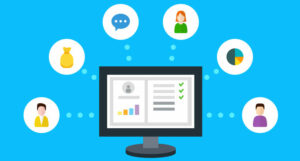Here are our top tips for getting the most from your CRM software.
1. Integrate all communications with the CRM platform
A CRM system is only as good as the information it receives. Ensuring that all available data avenues are feeding into the database is a key task in managing the CRM.
This enables the system to become the leading platform – rather than one among many – for operations and communications.
“Your contact centre should integrate with your CRM solution to create a single customer success platform designed around customer interaction. By using the rich customer data held in the CRM system to fuel conversations with customers, agents can ensure every conversation is meaningful,” said Tim Pickard, CMO at NewVoiceMedia.
2. Make the CRM system accessible to everyone
Enterprises should avoid making assumptions about who might need access to their CRM system – the answer is everyone. The worst word in data-driven industry is ‘silo’, yet data silos are allowed to flourish, on the basis that some staff won’t benefit from CRM software.
When this happens, it’s usually because a business has adopted CRM technology with a specific purpose in mind – such as improving customer retention or monitoring sales – and only wants to provide the software to stakeholders in that project.
This is an unnecessary limitation to place on a solution that has flexibility to answer the needs of various groups.
3. Make data visibility customisable
Different users will have different requirements of CRM software. A technical advisor might only check the specifications of a customer’s product. Sales representatives, however, might use all kinds of background information to inform their pitch.
Although businesses like to focus on a consistency of service, individual agents will have the greatest understanding of what helps them to do their jobs.
Allowing staff to select and prioritise the data they see will enable the system to better serve their needs. Changing their view of customer data might be as basic a requirement for staff as changing the height of their chair.
4. Ensure that agents collect data ‘on the ground’
Some of the most meaningful data a business can have at its disposal is rarely collected through automatic processes.
On many occasions, simple things like a preferred form of address or the correct pronunciation of a name are the easy wins that are overlooked.
More sensitive issues, such as a change in a customer’s relationship status, can have a great impact if an agent gets it wrong. Even worse is if multiple agents make the same mistake.
Staff should be briefed on the importance of recording these kinds of items as a matter of priority. The simple message to give them is: if it was important to this call, it will probably be important to future calls.
5. Use CRM to customise multichannel interactions
Many contact centres are still finding it difficult to answer the challenges posed by the multi/omnichannel environment. A well-deployed CRM can help with this, partly by using customer channel preferences as entirely new sources of data.
Customer experience also benefits from the ability to interact in the customer’s channel of choice, meaning that the CRM’s analysis of customer preferences helps meet customer needs.

Chuck Schaeffer
“A top call centre imperative is omnichannel communications. Call centres improve customer response and satisfaction when they communicate on the channels customers prefer, maintain conversation fidelity across channels and deliver personalised customer experiences. CRM software is the underlying technology to automate these increasingly vital customer experiences,” said Chuck Schaeffer, Go-to-Market Leader of Global Business Services at IBM.
6. Back up a good system with a good strategy
New software will do little to benefit a business that has no clear goals around how to use it.
Adaptability is among the key benefits of modern CRM software. With so many potential functions, purchasers need to understand what the role of the software is going to be.
Stakeholders need a clear idea of what CRM success looks like, and should develop goals which are SMART (Specific, Measurable, Agreed, Realistic, Time-based).
Identifying knowledge gaps and shortfalls in customer experience will indicate what CRM priorities should be. These should be subject to regular review to determine if progress is being made and how the CRM implementation might need to be adapted.
7. Train employees to use the system
This might seem like an obvious piece of advice, but time after time, CRM software projects have failed because users lack the expertise to make them work.
This is often due to a failure to explain what the CRM is, aside from a database. It’s not uncommon to find agents who have not adopted newer CRM systems even after several months.
Rigorous training is needed to build user confidence and to demonstrate the value to everyday processes. This generates both buy-in and competence.
Training can be reinforced through a well-organised and accessible collection of reference materials. It can also help to intensively train a select group as ambassadors, who can act as a knowledge base for other agents in the first few months of implementation.
8. Be aware of data ‘vintage’
Maintaining up-to-date information is a key task in database management. For agents on the frontline, it can be extremely helpful to know when the information they are using was gathered, as this is a strong indicator of reliability.
If a data item has not been renewed recently, this should be made clear to the user in a way that is immediately obvious, such as with ‘traffic light’ type colour coding.
Agents should also be prompted to reconfirm this data when making contact with the customer. Confirming pieces of information on an ad hoc basis like this is an easy and low-cost way to maintain the relevance of the database.
9. Agents should embrace ‘follow-up’ functionality
The days of relying on post-it notes or ‘from: self – to: self’ emails are gone – or at least, they should be. Follow-up functionality is the easiest way for agents to keep track of customers and to plan future contacts.
Likewise, internal tasks such as service requests and collaborations can be tracked much more effectively through the CRM system. This enables a greater degree of accountability, helping to spread workloads more evenly and helping managers to plan. It also makes a major contribution to preventing work loss and duplication.
10. Distinguish between ‘CRM’ and ‘CRM software’
This message frequently gets lost along the way, but ‘CRM’ and ‘CRM software’ are not the same thing.
Customer relationship management is a business practice which enterprises value for a variety of reasons.
CRM software is the platform that enables a business to manage customer relations. It’s a significant difference, and understanding it can change an organisation’s entire approach to customer relationships.
Rather than collecting data to ‘feed’ the database and to demonstrate their capacity to record facts, organisations collect data to plan more satisfying encounters with customers.

Tim Pickard
Making clear the difference between the process and the software is an important sea change in how people respond to the technology, because afterwards they will know why their actions are important.
With thanks to Tim Pickard, CMO at NewVoiceMedia, for his help in compiling this article.
Author: Rachael Trickey
Published On: 27th Sep 2016 - Last modified: 22nd Mar 2017
Read more about - Technology, Customer Relationship Management (CRM), Vonage

















